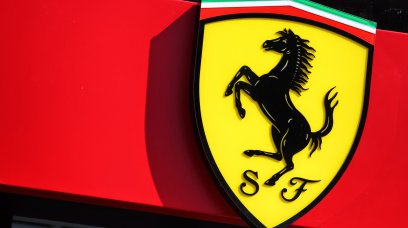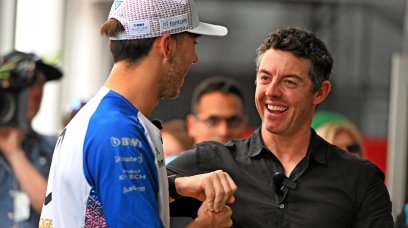From the world of sim racing, growing into Formula 1 - it's something that many young racing talents have in mind.
Whether it will ever come to pass remains to be seen, because the road to F1 is one full of obstacles. Not only for drivers, but also for other employees at teams in the premier class of motorsport.
Atze Kerkhof, a driver performance consultant at Stake F1 is an example of what the road towards the pinnacle of motorsport can look like. The Dutchman showed that you can make it to Formula 1 from sim racing as a driver performance consultant.
In an exclusive interview, RacingNews365 asked Kerkhof exactly what his role at Stake F1 looks like: "The setup and driving determine the vehicle dynamics.
"That's about how a car moves, how you create the optimal grip with your accelerator and brake pedals, the steering wheel and your gears.
"To bring all that together is like tightrope walking, where the balance has to be absolutely perfect to get through the corner in the best possible way.
"Everything I've learned during my career in elite sports, sim racing and the engineer's part makes me understand the car, but even more so how a driver can have the optimal grip every time.
"After all, you have to have the grip in the car with a fluid movement, instead of moving the car like crazy which only slows it down."
That fluidity, and how responsive the car has been, is something that is often named by drivers after the various sessions.
In particular, former drivers express their admiration for how today's Formula 1 drivers steer in a fluid, flowing motion.
"This fluid style is actually very unnatural for a lot of drivers. When you tell drivers to push, they actually start working harder in the car," Kerkhof explains. "That way you end up just driving slower.
"That is the piece of vehicle dynamics where everything comes together and where you have to understand and be able to imagine how to get the most out of the car.
"You have to take all the data, a lot of it is reflected in the telemetry, and from there you can paint a picture about how to tell the driver how to drive.
"So you're always looking for which driving style provides the most grip. Maybe that style may seem less fast to a driver sometimes, but the advised way is ultimately the fastest way to finish the lap, also because you're using the tires optimally. To make that happen, however, you have to get a lot of people moving in the same direction."
Viewed by others:
The feedback challenge
Nevertheless, convincing a driver is still not easy. Although, there are also drivers who mainly give the feedback to the engineers themselves rather than the other way around.
"In any sport and with any athlete, of course, giving feedback is difficult," Kerkhof stated. "It should cause an athlete to do something different because it would be better. However, that goes against the driver's ego.
"So that's already difficult, because you have to be able to explain something very well. You have to be able to point that out really clearly, with different tools like actual data. Otherwise the driver doesn't pick it up.
"The next step is whether the driver can also change his driving style. You have to keep working on that over and over again and that is a long process.
"However, everyone knows that you can always find two or three-tenths and just look what a difference that makes in qualifying in 2024.
"All drivers are under pressure right now because of the current driver market and so they know how important it is to find just that half-tenth in qualifying, so starting from the first free practice, we also have to work on being as efficient as possible. You have to go in the right direction as soon as possible, to get the whole picture of the set-up right.
"In the team's factory, during such a race weekend, a lot is collected in terms of data and the conclusion of that is used to find another better set-up the next day.
"You have three aspects, the set-up of the engineers, driving tools of the performance engineer [who provide input per corner about what the driver needs to change in order to be more stable and faster through the corner] and the driver part.
"You have to bring those three aspects together. My role is to go in one direction with all three together, and thus bring synergy to the whole picture.
"That process goes in three steps. What does the driver have to do? How is the car going to respond to that or what do we need from the car? And ultimately, how can we bring this together? Those are the three steps in the process."
Although it is a process that is easy to describe, it is not necessarily so easy to perfectly execute.
"You are dealing with multiple insights and also every driver is different," he added. "So you have to adjust the process with each driver as well.
"Every driver has his own approach and that's why it varies a lot from one driver to the next on what a process looks like."
Viewed by others:
Working with Max Verstappen
Prior to joining Sauber at the behest of Xevi Pujolar, Max Verstappen's former race engineer, Kerkhof started out doing competitive sim racing.
That led to the opportunities at feeder category team Van Amersfoort Racing, where the Red Bull driver was part of the set up. The pair worked together, with Kerkhof tasked with setting benchmark times for the young drivers to match.
Eventually, Verstappen was brought into the fold at sim racing outfit Team Redline, where Kerkhof already was and remains to this day with his compatriot.
"When I look at Max Verstappen on the current grid, for example, he has a 99% feel for what he needs and knows how to indicate what needs to be done," Kerkhof said of the three-time F1 drivers' champion. "He is very easy to do that and that is why he is a very easy person to work with for a team.
"After all, they just have to do what he wants and then it will work out. That is not true for every driver and then sometimes some friction arises between the driver and the team.
"During race weekends where one experiences a bad free practice at a team, you see that reflected in the fact that someone like Verstappen manages to steer the team in the right direction in the end.
"So that's where some drivers differ from each other as well, because for many drivers it's the other way around. They need the engineers' input more instead of being able to give the engineers the right input."
Also interesting:
Join RacingNews365's Ian Parkes, Sam Coop and Nick Golding, as they discuss where Max Verstappen's São Paulo victory ranks amongst the best in F1 history, and whether McLaren's title chances have taken a big blow.
Rather watch the podcast? Then click here!
Don't miss out on any of the Formula 1 action thanks to this handy 2026 F1 calendar that can be easily loaded into your smartphone or PC.
Download the calenderMost read
In this article
















Join the conversation!